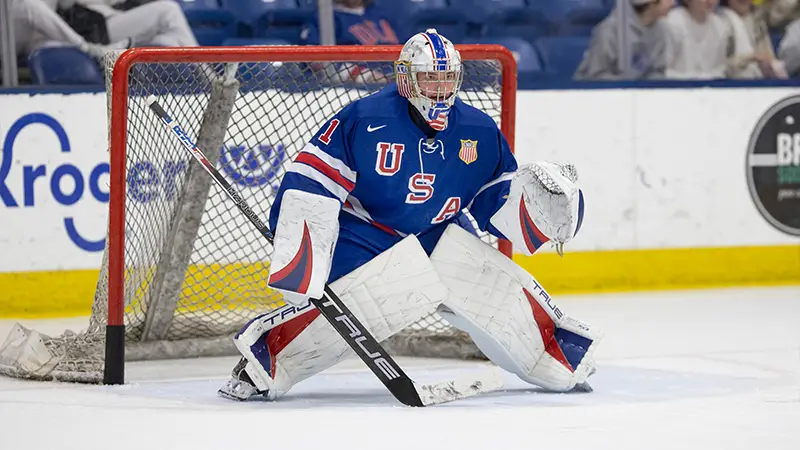In the fast-paced and highly ritualistic world of hockey, every player’s jersey number holds its own unique significance. Yet, when it comes to goaltenders, the numbers 1 and 30 stand out like sentinels guarding the net.
Ever wondered Why are hockey goalies number 1 or 30? In this exploration, we delve into the captivating history and mystique behind the numbers donned by these last lines of defense. The goalie’s jersey number isn’t just a digit; it’s a symbol of tradition, superstition, and, often, remarkable achievements.
Whether it’s the iconic “1” that pays homage to the keeper of the crease or the legendary “30” made famous by an NHL great, these numbers carry stories, superstitions, and a sense of identity unique to each netminder.
Join us as we unravel the tales and delve into the rituals surrounding these numbers, discovering why they resonate so deeply with the guardians of the goal. So, stay focused.

The Historical Origins of Hockey Jersey Numbers
The practice of assigning jersey numbers in hockey has a long and evolving history, with its origins dating back to the early days of the sport in the late 19th century. Here’s a brief overview of the historical origins of hockey jersey numbers:
No Numbers
In the early days of ice hockey, there were no standardized jersey numbers. Players typically wore plain, unnumbered sweaters, and team identification was often based on the colors and distinctive patterns of their jerseys.
Early Use of Numbers
The use of numbers on hockey jerseys began to emerge in the early 1900s. At first, these numbers were used primarily for organizational purposes, helping coaches and players identify their teammates during games and practices.
Identification and Scoring
As the sport grew in popularity, numbering players became more common, primarily for the benefit of fans, coaches, and officials. Having numbers on jerseys made it easier for spectators to identify individual players and for referees to call penalties or goals accurately.
Position-Based Numbers
In the early years, some teams started to assign specific numbers to players based on their positions. For example, defensemen might wear numbers in the 1-6 range, forwards in the 7-12 range, and goalies in the 1-30 range. This practice wasn’t universal, though, and it evolved over time.
Personal Preferences
Throughout the early to mid-20th century, players often had personal preferences for jersey numbers. These preferences were often based on superstitions or other personal reasons.
For example, some players chose numbers that were significant to them, while others believed certain numbers brought them good luck.
League Standardization
In the National Hockey League (NHL), jersey number rules became more standardized as the league grew. In 1951, the NHL implemented a rule that restricted players to using numbers between 1 and 30. This rule aimed to help referees identify players more easily.
Retired Numbers
Over time, some teams in the NHL began retiring jersey numbers to honor legendary players. This practice has become common across many sports, and it serves as a way to pay tribute to players who have made significant contributions to their teams and the sport as a whole.
Today, jersey numbers in hockey continue to have significance, and players often choose numbers with personal meaning or historical significance.
The practice of retiring jersey numbers remains common in the NHL, with many teams honoring their most iconic players by hanging their retired numbers in the rafters of their arenas.
The Importance of Number 1 for the Goalies

The number 1 jersey holds special significance in hockey, particularly for goaltenders. Here are several reasons why the number 1 is important for goalies:
Traditional Role
Historically, goalies have worn the number 1 jersey as a way to distinguish their unique position on the team. While other players may wear numbers in the teens or twenties, goalies almost universally wear number 1, making it a symbol of their role as the last line of defense.
Identification
The number 1 jersey makes it easy for players, coaches, officials, and fans to identify the goaltender on the ice. This is especially important in fast-paced games, as it helps prevent confusion and ensures that the right player is credited with saves and goals.
Psychological Factors
Goalies are often considered the most mentally resilient players on the team, as they face tremendous pressure and responsibility. Wearing the number 1 jersey can serve as a reminder of their unique role and the need to be mentally strong and confident in the net.
Iconic Goalies
Many of the greatest goaltenders in hockey history, including legends like Jacques Plante, Terry Sawchuk, and Martin Brodeur, wore the number 1 jersey. As a result, the number has become associated with some of the sport’s all-time greats, adding to its prestige for goalies.
Legacy and Tradition
Hockey is a sport steeped in tradition, and the use of the number 1 for goaltenders is a tradition that has been passed down through generations. It connects modern goaltenders to the rich history of the game.
Marketing and Merchandise
The number 1 jersey is often a top-selling item for fans, as many young players aspire to become goaltenders and want to emulate their favorite netminders. This popularity can also make the number 1 jersey a marketable commodity for teams and players.
Leadership and Accountability
Goalies are often seen as leaders on their teams, and wearing the number 1 jersey can symbolize their leadership role. They are expected to set an example for hard work, focus, and determination, both on and off the ice.
The number 1 jersey for goaltenders is more than just a number; it represents the unique and crucial role that goaltenders play in the game of hockey. It is a symbol of tradition, identity, and leadership, and it carries a rich history of some of the sport’s most iconic figures.
The Importance of Number 30 for the Goalies

The number 30 holds special significance for goaltenders in hockey, particularly in the National Hockey League (NHL). While the importance of the number 30 for goalies may not be as universal as the number 1, it has become iconic in its own right for several reasons:
Martin Brodeur
The most prominent reason for the significance of the number 30 for goaltenders is Martin Brodeur, one of the greatest goalies in NHL history.
Brodeur spent the majority of his illustrious career with the New Jersey Devils and wore the number 30 jersey throughout his time with the team. His success and the records he set while wearing the number 30 have made it synonymous with his name.
Records and Achievements
Martin Brodeur holds numerous NHL records, including most career wins, most career shutouts, and most single-season wins. His exceptional career accomplishments while wearing the number 30 have elevated the jersey number’s status in the league.
Legacy and Influence
Martin Brodeur’s style of play and his longevity in the league have had a lasting impact on goaltending. Many young goaltenders have looked up to him and aspired to be like him, further cementing the number 30 as a symbol of excellence for goalies.
Retired Number
In recognition of his contributions to the New Jersey Devils and the sport of hockey, the team retired the number 30 jersey in honor of Martin Brodeur. This is a rare and significant tribute, further solidifying the importance of the number 30.
Association with Success
The number 30 has become associated with success and elite goaltending in the NHL, thanks to Martin Brodeur’s career. When a goalie wears the number 30, there is often an expectation of high performance and excellence.
Popular Choice
In part due to Brodeur’s influence, many young goaltenders choose to wear the number 30 in honor of their hockey hero. This has made it a popular choice among aspiring goaltenders.
While the number 30 may not have the same historical significance as the number 1 for goaltenders, it has acquired its own unique importance and legacy within the world of hockey, particularly in the NHL.
Can the Goalies Get Other Numbers Except 1 and 30?

Yes, goaltenders in hockey can wear numbers other than 1 and 30. While numbers 1 and 30 are traditionally associated with goaltenders and are often chosen by goalies due to their historical significance, there are no strict rules that restrict goaltenders to these specific numbers.
In fact, goaltenders in various leagues around the world have worn a wide range of jersey numbers, including single-digit numbers, numbers in the teens, and numbers in the twenties.
The choice of jersey number for a goaltender is typically a personal preference, and it can be influenced by various factors, including superstitions, favorite numbers, or even the availability of certain numbers on the team roster.
Some goaltenders may choose numbers that have personal meaning to them or that hold significance in their lives. While numbers 1 and 30 are iconic for goaltenders, the rules and traditions regarding jersey numbers can vary from one league to another.
Some leagues may have specific rules or guidelines regarding jersey numbers, while others may allow more flexibility in the choice of numbers.
Superstitions and Rituals Regarding Goalies Jersey Number
Superstitions and rituals are prevalent in the world of sports, and goaltenders in hockey are no exception. While superstitions and rituals regarding jersey numbers can vary widely from one goaltender to another, here are some common examples of how these beliefs may manifest:
Lucky Numbers
Many goaltenders have a superstition or belief in certain numbers being “lucky” for them. This could be a number they’ve had success with in the past or a number that holds personal significance.
For example, a goaltender might choose a number that corresponds to their birthdate or another meaningful event in their life.
Unlucky Numbers
On the flip side, some goaltenders may avoid certain numbers they consider unlucky. This could be due to past negative experiences associated with a particular number or simply a personal preference against it.
Consistency
Some goaltenders are highly superstitious about consistency. They may believe that changing their jersey number mid-season or mid-career can disrupt their performance, so they stick with the same number as long as possible.
Routine Dressing
The process of putting on the jersey can be ritualistic for goaltenders. Some may have specific routines they follow when getting dressed, such as putting on each piece of gear in a certain order or having a particular method for tucking in their jersey.
Visualization
Before a game, goaltenders often spend time visualizing their performance and success. Some may incorporate their jersey number into this mental preparation, envisioning themselves making key saves while wearing their number.
Pre-Game Rituals
Goaltenders, like many athletes, often have pre-game rituals that they follow religiously. These rituals can include everything from a specific meal or snack to a particular way of taping their stick or putting on their jersey.
Lucky Charms
Some goaltenders have lucky charms or items they carry with them in their equipment or jersey. These can be personal talismans that they believe bring them good luck on the ice.
Touching the Number
It’s not uncommon for goaltenders to touch or tap their jersey number before stepping onto the ice. This can be a way to mentally prepare and focus before the game.
Team Unity
Some goaltenders choose their jersey number based on its significance within the team. For example, they may choose a number that corresponds with their position in the team’s goaltending hierarchy or reflects their role as a leader on the squad.
It’s important to note that these superstitions and rituals are highly individual and can vary widely from one goaltender to another. They can be a way for players to build confidence, find motivation, and create a sense of routine and control in a high-pressure environment.
FAQs
Why do many hockey goalies wear the number 1 jersey?
Many hockey goalies wear the number 1 jersey because it symbolizes their position as the “first” line of defense. It has historical significance, highlighting the goalie’s role as the last barrier against opponents’ scoring attempts.
What’s the significance of the number 30 for hockey goaltenders?
The number 30 gained significance mainly due to legendary goalie Martin Brodeur. His remarkable career and records while wearing #30 made it iconic for goalies. It’s a tribute to his excellence and has become a symbol of elite goaltending.
Can a goalie choose any number for their jersey?
Yes, goaltenders can choose jersey numbers beyond 1 or 30. While these numbers are traditional, many goalies pick numbers based on personal preference, superstitions, or significance. Rules may vary by league, but generally, there’s flexibility in selecting a number.
Are there any superstitions surrounding goalie jersey numbers?
Yes, superstitions are common among goalies. Some believe certain numbers are “lucky” or “unlucky,” while others associate their performance with their jersey number. Many have rituals related to their number, like touching it before a game, as part of their mental preparation.
Why are goalie jersey numbers so important in hockey?
Goaltender jersey numbers are important as they reflect tradition, history, and individual identity. They help fans, officials, and players identify goalies easily. The choice of number, whether 1, 30, or another, can carry personal meaning and connect goalies to the sport’s rich heritage.
Wrapping Up
In the world of hockey, jersey numbers are more than just identifiers; they are woven into the very fabric of the game’s history and culture. For goaltenders, the numbers 1 and 30 hold a special place, embodying tradition, superstition, and excellence.
As we’ve explored, whether a goalie chooses to don the number 1 in homage to the position’s singular importance or opts for the number 30 in tribute to a legendary predecessor, these choices carry deep meaning.
From personal superstitions to team traditions, these numbers become part of a goaltender’s identity and contribute to the captivating tapestry of hockey lore.
Whether it’s number 1, 30, or any other digit, the goalie’s jersey is a symbol of dedication, resilience, and the unwavering commitment to protecting the goal at all costs—an enduring legacy in the ever-evolving world of hockey.




Benjamin Kenyon